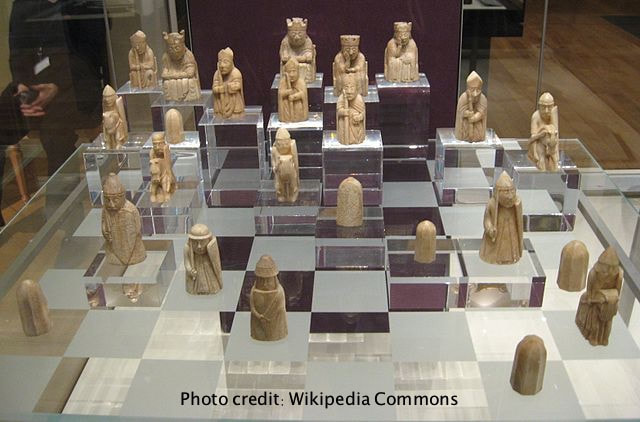|
Discovered in 1831 on the Isle of Lewis in the Outer Hebrides, the Lewis Chessmen are one of the most famous artifacts found in Europe. Numbering about 93 pieces, the chessmen are mostly carved from walrus ivory and date to the 12th century. For many years historians have attributed the origin of the pieces to Norway. Researcher and author Nancy Marie Brown, however, has raised the possibility that the set may have in fact been carved in Iceland by an artisan known as Margaret the Adroit. If so, it would then be likely that the chess pieces were given as gifts to Norwegian nobility by an Icelandic bishop or other high ranking official. Regardless, the highly unusual chess figures have stoked the imagination of archeologists and historians ever since their discovery. Presently, 82 pieces reside in the British Museum, 11 in the National Museum of Scotland, with four pieces unaccounted for. Until last month, the total of missing pieces was five but a recent discovery now has a placed one piece in private hands. Purchased by a now-deceased Scottish antiques dealer for $6 in 1964, the piece was found in a drawer by the dealer's heirs and brought to market via Sotheby's. Estimated at $670,000 - 1.2 million, the chess piece hammered down for $927,500, thus making it the most expensive chess piece ever sold at auction. The buyer chose to remain anonymous and whether the piece will be placed for public viewing in the future remains unknown. Although this is an extreme example, it also illustrates a mantra of mine: always get things checked out if you are unsure as to whether an item has value. Odds are, you won't have a Lewis Chessmen piece on your hands, but it doesn't mean you don't have something of value! NOTE: For further reading on Brown's theory of Icelandic origin, you can track down her book, Ivory Vikings: The Mystery of the Most famous Chessmen in the World and the Woman Who Carved Them (St. Martin's Press, 2015). Comments are closed.
|
AuthorBryan H. Roberts is a professional appraiser in Sarasota, FL. He is a member of the Florida State Guardianship Association and currently serves on the board of the local FSGA chapter. He is a past president of the Sarasota County Aging Network, a non-profit that provides grants to other non-profits benefiting seniors in need and is also a board member of PEL, an area non-profit whose resale store profits support programs and scholarships for at-risk and disadvantaged youth. He is certified in the latest Uniform Standards of Appraisal Practice (USPAP) Equivalent Archives
May 2024
Categories |


 RSS Feed
RSS Feed